Seismic Community Gathers for SITS
 The 2013 Seismic Instrumentation Technology Symposium (SITS) was held in Albuquerque, NM on June 10th and 11th, 2013. The well-attended symposium provided a splendid opportunity for members of the seismic community to exchange knowledge on instrumentation, as well as on novel approaches for improving the usefulness of data.
The 2013 Seismic Instrumentation Technology Symposium (SITS) was held in Albuquerque, NM on June 10th and 11th, 2013. The well-attended symposium provided a splendid opportunity for members of the seismic community to exchange knowledge on instrumentation, as well as on novel approaches for improving the usefulness of data.
Here are some informal moments from the symposium, which was capped by a Tuesday afternoon tour of the Albuquerque Seismological Laboratory (ASL). Copies of symposium presentations are posted for perusal at the conference agenda page.
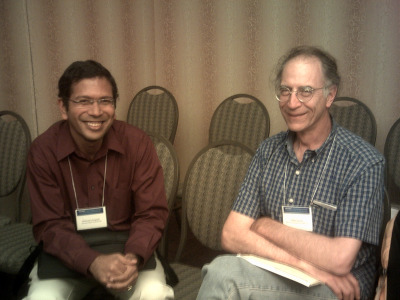 |
Srikanth Saripalli (Arizona State, at left) talks shop with Allan Sauter (EarthScope EPIC). |
|
Albuquerque Seismic Laboratory Scientist-in-Charge Lind Gee visits with EarthScope EPIC Program Manager James Gridley. |
 |
 |
John Hole of Virginia Tech talks about EarthScope's Large N initiative. He emphasized that, in regard to enhancement of tomographic data, geographical density of arrayed sensors (Large N) is critical to the avoidance of spatial aliasing. |
|
Raffaella Montelli (Geophysics Program Director, National Science Foundation) and Bob Woodward (Director of Instrumentation Services, EarthScope) get in some networking between presentations. Raffaella spoke on "NSF's Innovation Call: A Suite of Relatively Untapped Opportunities for GEO PIs." |
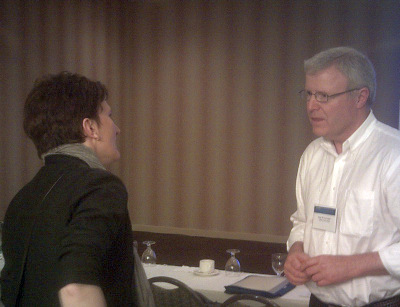 |
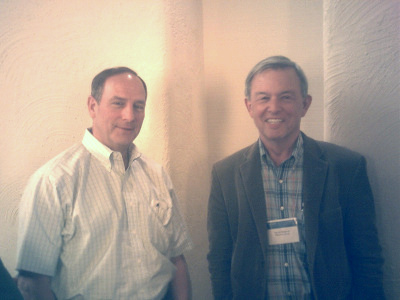 |
Rob Woolley(Director of Program Support and Special Projects at EarthScope) and David Simpson (President of EarthScope) pose for a picture in the foyer. |
|
Bob Woodward and Kent Anderson (GSN Program Manager for EarthScope) compare notes after a presentation. |
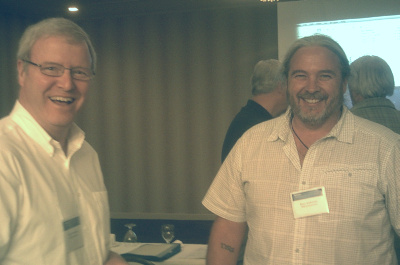 |
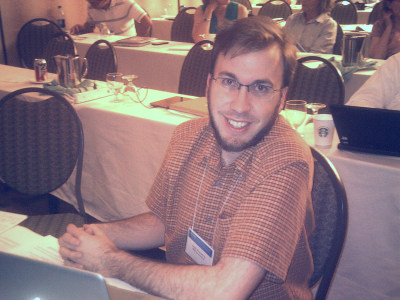 |
Conference organizer Andrew Frassetto did a splendid job of overseeing the symposium. |
|
George Slad of EPIC (right), joined by EPIC's "The Most Interesting Man in the World" mascot (left), attend the EPIC poster presentation on Sensor Emplacement Testing at Poker Flats, Alaska. |
 |
 |
Sridhar Anandakrishnan (Penn State) talks to the audience about Active and Passive Source Glacial Seismology. |
|
After the conference, Charles R. "Bob" Hutt (center, wearing hat) led a tour of the the Albuquerque Seismic Laboratory (ASL) facility, located south of Kirtland Airforce Base, in Isleta Pueblo. Hutt was formerly Scientist-in-Charge at ASL for 17 years, and currently serves as a Senior Scientist at the lab. |
 |
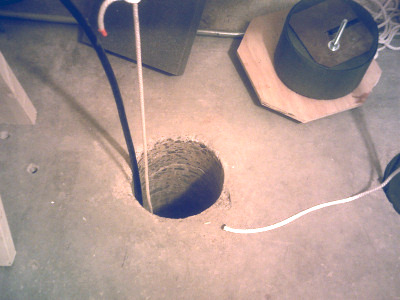 |
One of several permanent boreholes located inside a tunnel at ASL; these provide easy access for sensor testing and evaluation. |
|
Bob Hutt demonstrates one of the many historical artifacts and museum pieces stored at ASL. This device, the "Falling Pin" seismometer, advised users that it "Provides Valuable Evidence in Court Cases." |
  |
 |
This GPS station at ASL is anchored to bedrock several meters below the surface. It is part of the Plate Boundary Observatory (PBO) network. |
|
During the ASL tour, Albuquerque was experiencing a 100oF+ heat wave. That made this shady tree an attractive spot for resting between tour stops. |
 |
 |
EarthScope/EPIC summer intern Kasey Aderhold is shown holding an original ASL measurement of the huge 1964 Anchorage, Alaska earthquake. |
|
The ANMO station of the Global Seismographic Network (GSN) was one of the stops on the ASL tour. This station turns out to have one of the lowest noise floors of the GSN and other networks, and was key in defining the Peterson New Low Noise Model. |
 |
The symposium and tour provided many opportunities for the exchange of ideas and enthusiasm. The next symposium is expected to be held in the summer of 2015.
- Home
- General Information
- Instrumentation
- Dataloggers
- Sensors
- All-In-One Systems
- Power Systems
- Field Procedures
- Controlled Sources
- Seismic Source Facility
- Magnetotelluric Systems at EPIC
- Ground Penetrating Radar
- GNSS/GPS Receivers
- Power and Memory Calculations Form
- Data Archiving
- Apply for a PI Account
- Experiment Scheduling
- Polar
- Hardware & Software Notes
- Software
Also See
- Seismic Community Responds to Virginia Earthquake in a Big Way
- EPIC Obtains New Automated Seismic Source
- 2011 Seismic Instrumentation Technology Symposium Presentations Available On-Line
- Installing a "Cold and Dark" Seismic Station in the Yukon
- Facility Plan for Polar Seismic and Geodetic Science is Available


